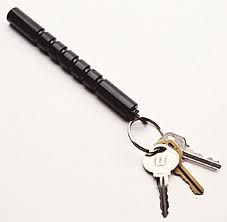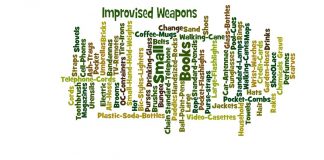The last defensive weapon I’ll talk about in this series is Kubotans.
First and foremost, always obey local laws. Country, State, County and even City ordinance and laws may be different or even in direct conflict with each other. Something that may be permissible under federal law may be criminal under your state law or even at the city level. The differences in restrictions apply to any weapon you might carry from handguns, to knives to kubotans.
 Second, you must get professional training. Always seek professional training in any weapon you intend to use or carry. This is absolutely critical in understanding and properly wielding any weapon. A good, professional instructor will teach you how to maintain the weapon, proper handling of the weapon, how to safely wield it, safe storage, help you select a model for your size and skill and a host of other essential items. Reading articles or watching DVDs are not enough. I cannot recommend hands-on, instructor led weapons training strongly enough.
Second, you must get professional training. Always seek professional training in any weapon you intend to use or carry. This is absolutely critical in understanding and properly wielding any weapon. A good, professional instructor will teach you how to maintain the weapon, proper handling of the weapon, how to safely wield it, safe storage, help you select a model for your size and skill and a host of other essential items. Reading articles or watching DVDs are not enough. I cannot recommend hands-on, instructor led weapons training strongly enough.
The kubotan was designed by Takayuki Kubota in the 1970s to be a less than lethal defensive weapon. The ends are blunt, specifically to cause no skin penetration, an important legal distinction. When used properly, it can induce a tremendous amount of pain to encourage compliance, but no lasting or permanent damage.
A kubotan is a small cylinder about .5-inch diameter (1.5 cm), between 5 and 6-inches long (12.5 and 15cm) and is usually made of wood, hardened plastic or aircraft aluminum. This defensive weapon falls into the general category of Self-Defense Keychain Stick (SDKS). It is held in one hand and can be used to strengthen fists when punching, the ends that protrude from a clenched fist can be used to strike pressure points or bone and it can be used to assist in joint locks for restraint and containment. Many come with a key ring at one end. When keys are attached, the kubotan can be used as a flail to whip your attacker. Kubotans can be purchased from many martial arts suppliers for between $5 and $10.
There are many variations on the kubotan. There is a similar martial weapon called the Yawara. Popular culture has bred the development of “ninja” kubotans that have spikes, pointed ends or even hidden blades. Those are not true kubotans and fall into a different weapon category all together (and many times a different legal category as well).
One of the many nice things about the kubotan is that it is a fairly safe defensive weapon, equivalent to a common stick when not used by a trained practitioner. If your 2-year old child picked it up you would not have the same level of concern as if a child picked up a handgun or knife. For those who might feel uncomfortable wielding a knife or handgun, the kubotan might be a good alternative. Finally, the kubotan is not subject to many of the carry restrictions that you find with knives or guns. However, you are still unable to carry it onto a plane or into any weapon-restricted facility manned by well-educated security personnel.
The main downside to the kubotan is that it is not as a forceful defensive weapon as the handgun or knife. Additionally, the uneducated attacker, which most are, will not recognize it for what it is or what it can do, and so the fear and intimidation factor is lost when you deploy it.
In all, the kubotan is a fairly safe and effective defensive weapon and far better than nothing at all.
First published by Tae Kwon Do Times Magazine and used by permission.






